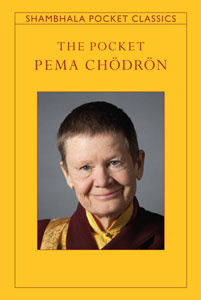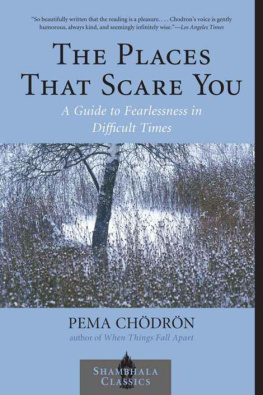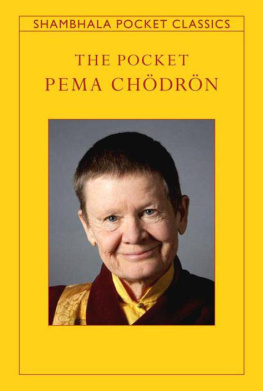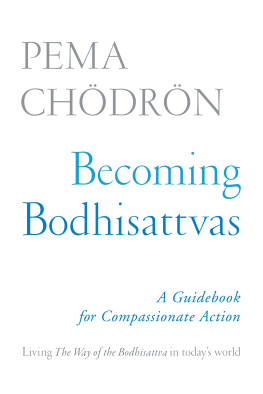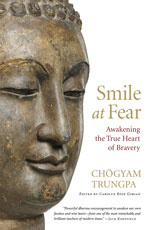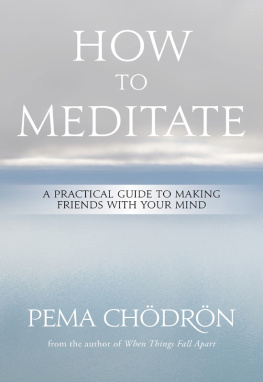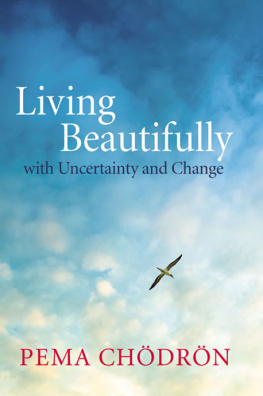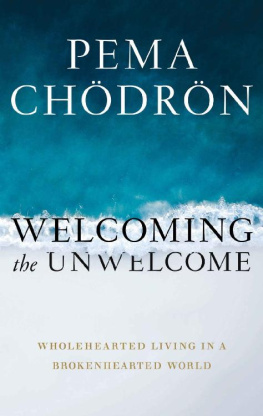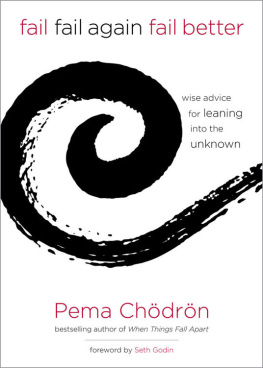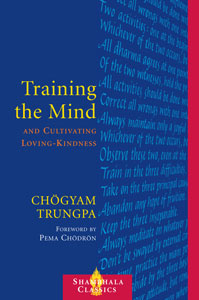These teachings are simple, earthy, and alive. Pemas deep experience and her fresh way of looking at things are like mountain waterclear and refreshing, as good Dharma should be.
Jack Kornfield, co-author of Seeking the Heart of Wisdom
ABOUT THE BOOK
Based on talks given during a one-month meditation retreat at Gampo Abbey, this book contains teachings that were intended to inspire and encourage practitioners to remain wholeheartedly awake to everything that occurs and to use the abundant material of daily life as their primary teacher and guide. The message for the retreat participantsand for the reader as wellis to be with oneself without embarrassment or harshness. This is instruction on how to love oneself and ones world.
This Shambhala Pocket Classic is an abridged version of The Wisdom of No Escape.
PEMA CHDRN is an American Buddhist nun in the lineage of Chgyam Trungpa. She is resident teacher at Gampo Abbey in Nova Scotia, the first Tibetan monastery in North America established for Westerners. She is the author of many books and audiobooks, including the best-selling When Things Fall Apart and Dont Bite the Hook.
Sign up to receive inspirational quotes from Pema Chdrn and special offers from Shambhala Publications.

Or visit us online to sign up at shambhala.com/eheartadvice.
Pema Chdrn

AWAKENING LOVING-KINDNESS

SHAMBHALA
Boston & London
2010
Shambhala Publications, Inc.
Horticultural Hall
300 Massachusetts Avenue
Boston, Massachusetts 02115
www.shambhala.com
1991, 1996 by Pema Chdrn
All rights reserved. No part of this book may be reproduced in any form or by any means, electronic or mechanical, including photocopying, recording, or by any information storage and retrieval system, without permission in writing from the publisher.
LIBRARY OF CONGRESS CATALOGING-IN-PUBLICATION DATA
Chdrn, Pema.
Awakening loving-kindness / Pema Chdrn.
p. cm. (Shambhala pocket classics)
eISBN 978-0-8348-2119-4
ISBN 978-1-57062-259-5
1. Spiritual lifeBuddhism. I. Title. II. Series.
BQ5625.C46 1996 96-7521
294.3444dc20 CIP
To my teacher,
Vidyadhara
the Venerable Chgyam Trungpa,
Rinpoche,
and to my children,
Arlyn and Edward
PREFACE
T HE TALKS in this book were given during a one-month practice period (dathun) in the spring of 1989. During that month the participants, both lay and monastic, used the meditation technique presented by Chgyam Trungpa that is described in this book. The formal sitting meditation was balanced by walking meditation and eating meditation (oryoki) and by maintaining the environment of the monastery and helping to prepare the meals.
Early each morning these talks were presented. They were intended to inspire and encourage the participants to remain wholeheartedly awake to everything that occurred and to use the abundant material of daily life as their primary teacher and guide.
The natural beauty of Gampo Abbey, a Buddhist monastery for Western men and women founded in 1983 by Chgyam Trungpa, was an important element in the talks. The abbey is located on Cape Breton Island, Nova Scotia, at the end of a long dirt road, on cliffs high above the Gulf of Saint Lawrence, where the wildness and playfulness of the weather, the animals, and the landscape permeate the atmosphere. As one sits in the meditation hall, the vastness of the sky and water permeates the mind and heart. The silence of the place, intensified by the sounds of sea and wind, birds and animals, permeates the senses.
During the dathun (as always at the abbey), the participants kept the five monastic vows: not to lie, not to steal, not to engage in sexual activity, not to take life, and not to use alcohol or drugs. The resulting collaboration of nature, solitude, meditation, and vows made an alternatingly painful and delightful no exit situation. With nowhere to hide, one could more easily hear the teachings given in these simple talks in a wholehearted, open-minded way.
The message for the dathun as well as for the reader is to be with oneself without embarrassment or harshness. This is instruction on how to love oneself and ones world. It is therefore simple, accessible instruction on how to alleviate human misery at a personal and global level.
I wish to thank Ane Trime Lhamo; Jonathan Green of Shambhala Publications, who encouraged me to publish a book; Migme Chdrn of Gampo Abbey, who transcribed and edited the talks; and Emily Hilburn Sell of Shambhala Publications, who shaped them into their present form. Whatever is said here is but my very limited understanding, thus far, of what my teacher, Chgyam Trungpa, Rinpoche, compassionately and with great patience showed to me.
May it be of benefit.
EDITORS NOTE
This is an abridged edition of The Wisdom of No Escape (Shambhala Publications, 1991). It contains all of the material published in the original edition except the following four chapters: Not Preferring Samsara or Nirvana, The Dharma That Is Taught and the Dharma That Is Experienced, Sticking to One Boat, and Inconvenience.
LOVING-KINDNESS
T HERES A common misunderstanding among all the human beings who have ever been born on the earth that the best way to live is to try to avoid pain and just try to get comfortable. You can see this even in insects and animals and birds. All of us are the same.
A much more interesting, kind, adventurous, and joyful approach to life is to begin to develop our curiosity, not caring whether the object of our inquisitiveness is bitter or sweet. To lead a life that goes beyond pettiness and prejudice and always wanting to make sure that everything turns out on our own terms, to lead a more passionate, full, and delightful life than that, we must realize that we can endure a lot of pain and pleasure for the sake of finding out who we are and what this world is, how we tick and how our world ticks, how the whole thing just is. If were committed to comfort at any cost, as soon as we come up against the least edge of pain, were going to run; well never know whats beyond that particular barrier or wall or fearful thing.
When people start to meditate or to work with any kind of spiritual discipline, they often think that somehow theyre going to improve, which is a sort of subtle aggression against who they really are. Its a bit like saying, If I jog, Ill be a much better person. If I could only get a nicer house, Id be a better person. If I could meditate and calm down, Id be a better person. Or the scenario may be that they find fault with others; they might say, If it werent for my husband, Id have a perfect marriage. If it werent for the fact that my boss and I cant get on, my job would be just great. And If it werent for my mind, my meditation would be excellent.
But loving-kindnessmaitritoward ourselves doesnt mean getting rid of anything. Maitri means that we can still be crazy after all these years. We can still be angry after all these years. We can still be timid or jealous or full of feelings of unworthiness. The point is not to try to change ourselves. Meditation practice isnt about trying to throw ourselves away and become something better. Its about befriending who we are already. The ground of practice is you or me or whoever we are right now, just as we are. Thats the ground, thats what we study, thats what we come to know with tremendous curiosity and interest.
Next page
